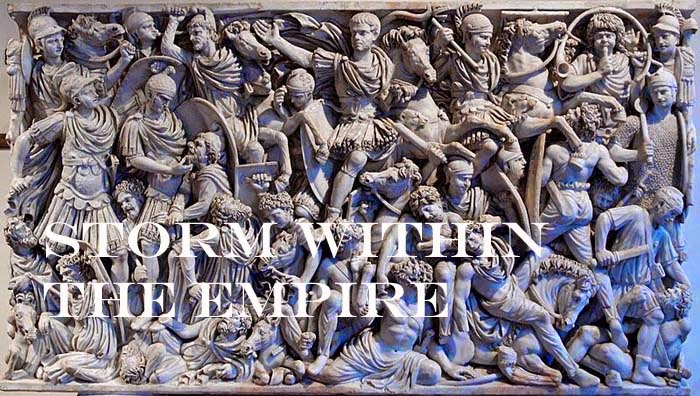The Iazyges became one of many new client-tribes of Rome during the reign of Tiberius, but details of their service and rewards are vague. Despite their status as a client state, tribes among the Iazyges conducted raids across the border into the empire. The situation soon escalated when the Iazyges, together with the Roxolani, Dacians, and Suebi invaded the Roman province of Pannonia in early 92 AD. Events are muddled, but highlight the victories of Domitian, but gloss over the annihilation of the Roman Legio XXI Rapax in battle. Much later, the Iazyges were again, during the Marcomannic War of 169, in conflict with Rome. but were soundly defeated by Marcus Aurelius.
The following test games, the Iazyges invade an arable region of Pannonia, consisting of a BUA (hamlet), two woods, a road, and river. Both commands have 24 elements, the composition of which can be found below.
Game one
Rome has
placed its forces to defend in depth. Positioned between a river and hamlet a
third line is placed further to the rear, guarding against any attempt at an
encirclement. Opposing them, the Iazyges have split their force in two, attempting
a two-prong attack, as Rome anticipated.
Remaining in its position, the Iazyges were handed the initiative and moved the main body of lancers slowly forward to allow the light horse time to distract the Roman left flank.
Beyond the village, Iazyges scouts engaged the Roman light horse, permitting the noble lancers to move closer in support. The movement against the Roman left was timed to allow the main body to wheel and face the Roman line.
Beating the Iazyge scouts, the Roman light horse retired to a position behind the village, well defended by three cohorts of auxilia. As the main enemy body closed the distance, it came into range of ballistae and archers. The resulting disorder enabled the Iazyges to make piecemeal attacks, with many being repelled. This continued for an hour (4 turns) causing light casualties on both sides.
In desperation, half the Iazyges lancers, led by their warlord, charged and broke the Roman line. The breaches, however, were filled by fresh troops from its reserve line. Beyond the village, the Iazyges continued to apply pressure eventually destroying Roman light horse to expose the Roman rear.
The last of
the reserves turned to face the oncoming threat, but as Roman losses were far
greater than those inflicted on the enemy, Rome had no alternative but to withdraw
from the field. Iazyges 8 - 4
Game two
Implementing
a different strategy, Rome deployed in an extended line with a portion of the
legion and all the cavalry in reserve.
Seeing the village posed a problem for the enemy deployment, the Roman auxilia, with cavalry in support, moved toward the village in two groups. While this took place, the Roman main body remained in position, preparing to receive an expected Iazyges assault.
From the village, Roman auxilia were attacked by enemy skirmishers losing two cohorts of auxilia. Their elation was short, as all the skirmishers were destroyed by the equites nearby. The equites soon found themselves the target by Iazyges lancers nearby.
At this
moment, the main body of Iazyges lancers attempted to time its charge against
the legion.
Unfortunately, the main body of Iazyges faltered (low pips), allowing two cohorts of legionnaires and artillery to smash a column of lancers. Roman morale lifted prompting more aggressive action to swing the battle in Rome’s favour.
Gaining no further traction, the Iazyges main body could make no impression on the Roman line, sensing victory slipping from their grasp. Opposite the village, Rome destroyed enemy light horse and killed their sub-general. The Iazyges left wing leaderless, the Iazyges warlord called for a retreat. Rome 8 – 5
Observations.
Game one, taking
advantage of the narrow field created by the river and village, Rome deployed
in depth to conduct a passive game. By turn nine, casualties were 3 – 2 in
Rome’s favour. The situation soon changed when the Iazyges launched suicidal
attacks giving them a 6 - 4 lead. On the following turn, the Iazyges managed to
cobble a group for one last charge to break Roman resistance.
Game two, Rome discarded the passive option and planned an aggressive defence. The village offered that opportunity. Moving toward the village, the auxilia split in two groups to threaten the interior flanks of the Iazyges cavalry. In response, the Iazyges sent troops to contend with the auxilia, resulting in fewer numbers meant to crush the Roman legion. The advance of the main body became disordered by ballistae bolts, requiring valuable time to redress their formation.
Forced to
fight two separate battles, Rome deepened the wedge between the two Iazyges wings
and killed the Iazyges sub-general. The resulting confusion (out of command
control of CinC) to a third of the army forced the warlord to end the battle.
Iazyges
16 x noble
cavalry (3Kn), 2 x scouts (LH), 6 x skirmishing archers (Ps).
Early
Imperial Roman
2 x General
(Cv), 2 x equites (Cv), 8 x legionnaires (4Bd), 6 x auxilia infantry (4Ax), 2 x
archers (4Bw), 2 x light horse (LH), 2 x artillery (Art).



















































